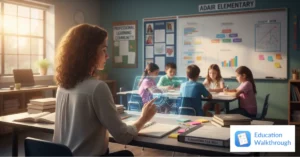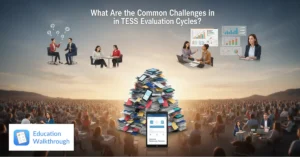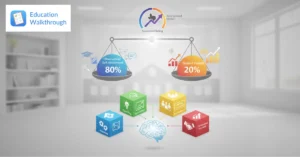Classroom walkthroughs have become a cornerstone in modern education for understanding and improving instructional practices. By conducting these short, focused visits, educators and administrators can gather valuable insights that create a comprehensive mosaic of a school’s educational landscape. These visits are not just about monitoring; they serve to capture the dynamic nature of teaching and learning, which can often be missed in formal evaluations.
This article delves into how classroom walkthroughs contribute to forming a school mosaic, highlighting their importance and offering practical tips for effective implementation. By understanding the nuances of these walkthroughs, educators can use them as a powerful tool for school improvement.
What Are Classroom Walkthroughs?
Classroom walkthroughs are brief, informal observations of classroom activities designed to provide snapshots of instructional practices. These walkthroughs typically last between 5 to 15 minutes and focus on specific aspects of teaching and learning. The brevity of these visits allows for more frequent observations, which is essential for gaining a well-rounded perspective on classroom dynamics.
Unlike formal evaluations, walkthroughs are meant to be low-stakes and supportive, fostering a culture of continuous improvement. They are designed to be non-intrusive and can occur seamlessly within the school day, minimizing disruption to the learning process.
The Importance of Classroom Walkthroughs
Enhancing Instructional Practices
One of the primary benefits of classroom walkthroughs is the enhancement of instructional practices. By regularly observing classrooms, administrators can identify effective teaching strategies and areas needing improvement. These insights can then be used to provide targeted professional development opportunities for teachers. Moreover, recognizing and celebrating effective practices can boost teacher morale and encourage the replication of successful methods across the school.
Frequent observations also allow administrators to track the implementation of new teaching strategies and curricula. This ongoing monitoring ensures that instructional changes are being adopted effectively and provides opportunities to offer timely support where needed.
Building a School-Wide Culture of Collaboration
Classroom walkthroughs encourage a culture of collaboration among teachers. When educators know that walkthroughs are part of the school’s routine, they are more likely to engage in open discussions about their teaching methods and seek feedback from their peers and administrators. This openness can lead to a more cohesive teaching community, where ideas and strategies are shared freely.
Furthermore, collaborative walkthroughs, where teachers participate in observing their peers, can foster a spirit of mutual support and learning. These peer observations can provide valuable perspectives and promote a sense of shared responsibility for student success.
Informing School Improvement Plans
Data gathered from classroom walkthroughs can be instrumental in shaping school improvement plans. Administrators can use this information to identify trends, set goals, and allocate resources effectively. This ensures that school improvement efforts are grounded in real, observable classroom practices. By basing decisions on concrete data, schools can make more targeted and effective changes.
Additionally, the data collected from walkthroughs can be used to track progress over time. This longitudinal view can help schools assess the impact of their improvement initiatives and make adjustments as needed.
Creating a Mosaic: How Walkthroughs Paint a Comprehensive Picture
Observing Diverse Instructional Styles
A single classroom observation might not provide a complete picture of a teacher’s instructional style. However, multiple walkthroughs across different classrooms and subjects can reveal a rich tapestry of teaching methods. This diversity is crucial for understanding the overall instructional landscape of the school. It highlights the various approaches teachers use to engage students and deliver content.
By observing a range of instructional styles, administrators can identify what works best in different contexts. This knowledge can inform professional development and help tailor support to meet the unique needs of each teacher.
Identifying Patterns and Trends
Through repeated classroom walkthroughs, administrators can identify patterns and trends in instructional practices. For instance, they might notice that certain teaching strategies are particularly effective in engaging students or that specific areas of the curriculum need more attention. Recognizing these patterns allows for more informed decision-making.
Identifying trends also enables schools to address systemic issues that might not be apparent from isolated observations. This comprehensive view can lead to more strategic and effective interventions.
Promoting Consistency and Coherence
Classroom walkthroughs can help ensure consistency and coherence in instructional practices across the school. By observing various classrooms, administrators can identify discrepancies and work towards aligning teaching methods with the school’s educational goals and standards. This alignment is essential for providing a uniform learning experience for all students.
Consistency in instructional practices also supports smoother transitions for students as they move from one grade level to the next. It helps maintain a continuous and cohesive learning journey, which is critical for student success.
Implementing Effective Classroom Walkthroughs
Setting Clear Objectives
Before conducting walkthroughs, it’s essential to establish clear objectives. What specific aspects of teaching and learning are you looking to observe? Having defined goals ensures that the walkthroughs are focused and productive. Clear objectives also help in setting expectations for teachers, reducing any anxiety they might have about the process.
Objectives can vary depending on the school’s current priorities. For example, a school focusing on literacy might look at how reading strategies are being implemented, while another focusing on student engagement might observe classroom interactions.
Using a Standardized Observation Tool
A standardized observation tool can help streamline the walkthrough process. This tool should include key indicators that align with the school’s instructional goals. By using a consistent framework, administrators can gather comparable data across different classrooms. This standardization is crucial for identifying patterns and making data-driven decisions.
The observation tool should be flexible enough to capture the nuances of different teaching styles while providing a clear structure for recording observations. This balance ensures that the tool is both comprehensive and user-friendly.
Providing Constructive Feedback
While the primary purpose of classroom walkthroughs is to gather data, providing constructive feedback to teachers is also important. This feedback should be specific, actionable, and supportive, aiming to foster professional growth rather than critique. Constructive feedback can help teachers understand their strengths and areas for improvement, promoting a culture of continuous learning.
Effective feedback should be timely and delivered in a manner that encourages reflection and dialogue. This approach helps build trust and makes teachers more receptive to the insights provided.
Encouraging Teacher Participation
Teachers should be encouraged to participate in the walkthrough process actively. This can include self-reflection, peer observations, and collaborative discussions. When teachers are involved, they are more likely to view walkthroughs as a valuable tool for professional development. Active participation also empowers teachers to take ownership of their growth and development.
Creating opportunities for teachers to observe their peers can provide valuable insights and foster a collaborative learning environment. Peer observations can lead to the sharing of best practices and innovative teaching strategies.

Overcoming Challenges in Classroom Walkthroughs
Balancing Frequency and Depth
One challenge in conducting classroom walkthroughs is finding the right balance between frequency and depth. While frequent observations provide more data, they can also be time-consuming. It’s essential to strike a balance that allows for meaningful insights without overwhelming educators. This balance ensures that walkthroughs are sustainable and do not become a burden.
Administrators can consider rotating the focus of their observations to cover different aspects of teaching and learning over time. This approach can provide a comprehensive view without the need for constant observations.
Ensuring Objectivity
Maintaining objectivity during walkthroughs can be challenging. Administrators must be aware of their biases and strive to observe with an open mind. Using a standardized observation tool can help mitigate this issue by providing a structured framework. Objectivity is crucial for ensuring that the data collected is accurate and reliable.
Regular training and calibration sessions for administrators can help maintain consistency and objectivity in observations. These sessions provide opportunities to discuss and align on what effective teaching looks like.
Managing Teacher Anxiety
Classroom walkthroughs can sometimes cause anxiety among teachers, especially if they feel they are being judged. To alleviate this, it’s crucial to communicate the purpose of walkthroughs clearly and emphasize that they are meant to be supportive and non-evaluative. Transparent communication can help build trust and reduce anxiety.
Creating a positive and supportive atmosphere during walkthroughs can also help. Acknowledging and celebrating good practices can make teachers feel valued and appreciated.

Real-World Examples and Success Stories
Case Study: Improving Literacy Instruction
At Lincoln Elementary School, classroom walkthroughs were instrumental in improving literacy instruction. Administrators conducted regular walkthroughs focusing on reading strategies and student engagement. The data collected revealed that while most teachers were using effective reading techniques, there was inconsistency in how they were implemented.
Using this insight, the school organized targeted professional development workshops, resulting in more consistent and effective literacy instruction across all classrooms. The impact was evident in improved student reading scores and increased engagement during literacy lessons.
Case Study: Enhancing STEM Education
At Jefferson Middle School, administrators used classroom walkthroughs to enhance STEM education. By observing multiple STEM classes, they identified that while teachers were incorporating hands-on activities, there was a lack of real-world applications. Administrators then introduced a series of professional development sessions focused on integrating real-world problem-solving into STEM lessons. The result was a more engaging and relevant STEM curriculum for students.
Students showed increased interest and participation in STEM subjects, and teachers reported greater confidence in delivering STEM lessons that connected with real-world scenarios.

Conclusion: Building a Mosaic for Continuous Improvement
Classroom walkthroughs play a crucial role in creating a mosaic of a school’s instructional practices. By providing snapshots of teaching and learning, they offer valuable insights that can inform school improvement efforts, enhance instructional practices, and foster a culture of collaboration. These insights are critical for making informed decisions that drive school success.
Effective implementation of classroom walkthroughs requires clear objectives, standardized observation tools, constructive feedback, and active teacher participation. While challenges exist, they can be overcome with thoughtful planning and open communication.
In the end, classroom walkthroughs are not just about observing; they are about understanding, supporting, and continuously improving the educational experiences of students and teachers alike. By building a comprehensive mosaic through these observations, schools can ensure that they are meeting their educational goals and providing the best possible learning environment for their students. This ongoing process of reflection and improvement is essential for fostering a thriving educational community.





